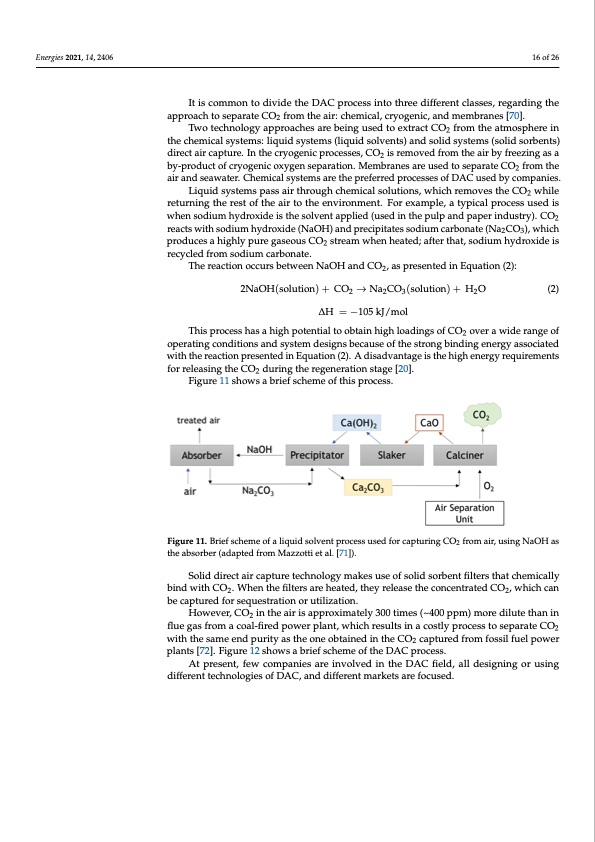
PDF Publication Title:
Text from PDF Page: 016
Energies 2021, 14, 2406 16 of 26 It is common to divide the DAC process into three different classes, regarding the approach to separate CO2 from the air: chemical, cryogenic, and membranes [70]. Two technology approaches are being used to extract CO2 from the atmosphere in the chemical systems: liquid systems (liquid solvents) and solid systems (solid sorbents) direct air capture. In the cryogenic processes, CO2 is removed from the air by freezing as a by-product of cryogenic oxygen separation. Membranes are used to separate CO2 from the air and seawater. Chemical systems are the preferred processes of DAC used by companies. Liquid systems pass air through chemical solutions, which removes the CO2 while returning the rest of the air to the environment. For example, a typical process used is when sodium hydroxide is the solvent applied (used in the pulp and paper industry). CO2 reacts with sodium hydroxide (NaOH) and precipitates sodium carbonate (Na2CO3), which produces a highly pure gaseous CO2 stream when heated; after that, sodium hydroxide is recycled from sodium carbonate. The reaction occurs between NaOH and CO2, as presented in Equation (2): 2NaOH(solution) + CO2 → Na2CO3(solution) + H2O (2) ∆H = −105 kJ/mol This process has a high potential to obtain high loadings of CO2 over a wide range of operating conditions and system designs because of the strong binding energy associated with the reaction presented in Equation (2). A disadvantage is the high energy requirements for releasing the CO2 during the regeneration stage [20]. Figure 11 shows a brief scheme of this process. Figure 11. Brief scheme of a liquid solvent process used for capturing CO2 from air, using NaOH as the absorber (adapted from Mazzotti et al. [71]). Solid direct air capture technology makes use of solid sorbent filters that chemically bind with CO2. When the filters are heated, they release the concentrated CO2, which can be captured for sequestration or utilization. However, CO2 in the air is approximately 300 times (~400 ppm) more dilute than in flue gas from a coal-fired power plant, which results in a costly process to separate CO2 with the same end purity as the one obtained in the CO2 captured from fossil fuel power plants [72]. Figure 12 shows a brief scheme of the DAC process. At present, few companies are involved in the DAC field, all designing or using different technologies of DAC, and different markets are focused.PDF Image | Current Developments of Carbon Capture Storage

PDF Search Title:
Current Developments of Carbon Capture StorageOriginal File Name Searched:
energies-14-02406.pdfDIY PDF Search: Google It | Yahoo | Bing
NFT (Non Fungible Token): Buy our tech, design, development or system NFT and become part of our tech NFT network... More Info
IT XR Project Redstone NFT Available for Sale: NFT for high tech turbine design with one part 3D printed counter-rotating energy turbine. Be part of the future with this NFT. Can be bought and sold but only one design NFT exists. Royalties go to the developer (Infinity) to keep enhancing design and applications... More Info
Infinity Turbine IT XR Project Redstone Design: NFT for sale... NFT for high tech turbine design with one part 3D printed counter-rotating energy turbine. Includes all rights to this turbine design, including license for Fluid Handling Block I and II for the turbine assembly and housing. The NFT includes the blueprints (cad/cam), revenue streams, and all future development of the IT XR Project Redstone... More Info
Infinity Turbine ROT Radial Outflow Turbine 24 Design and Worldwide Rights: NFT for sale... NFT for the ROT 24 energy turbine. Be part of the future with this NFT. This design can be bought and sold but only one design NFT exists. You may manufacture the unit, or get the revenues from its sale from Infinity Turbine. Royalties go to the developer (Infinity) to keep enhancing design and applications... More Info
Infinity Supercritical CO2 10 Liter Extractor Design and Worldwide Rights: The Infinity Supercritical 10L CO2 extractor is for botanical oil extraction, which is rich in terpenes and can produce shelf ready full spectrum oil. With over 5 years of development, this industry leader mature extractor machine has been sold since 2015 and is part of many profitable businesses. The process can also be used for electrowinning, e-waste recycling, and lithium battery recycling, gold mining electronic wastes, precious metals. CO2 can also be used in a reverse fuel cell with nafion to make a gas-to-liquids fuel, such as methanol, ethanol and butanol or ethylene. Supercritical CO2 has also been used for treating nafion to make it more effective catalyst. This NFT is for the purchase of worldwide rights which includes the design. More Info
NFT (Non Fungible Token): Buy our tech, design, development or system NFT and become part of our tech NFT network... More Info
Infinity Turbine Products: Special for this month, any plans are $10,000 for complete Cad/Cam blueprints. License is for one build. Try before you buy a production license. May pay by Bitcoin or other Crypto. Products Page... More Info
| CONTACT TEL: 608-238-6001 Email: greg@infinityturbine.com | RSS | AMP |